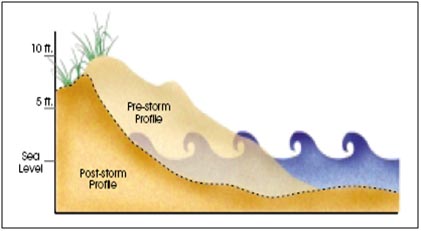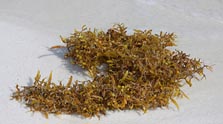Caring For Our Living Shoreline
Importance of preserving our beach
- Storm protection - a wide sandy beach helps separate storm waves from hotels and homes.
- Habitat restoration - numerous species such as the Kemp's ridley sea turtles and Piping Plovers rely on wide, healthy beaches as a place to live, feed, and nest.
- Economic Impact- Every year, there are over 2 billion visitors to America's beaches that support local economies.
Importance of a Healthy Dune System
Dunes are important because they are our first line of defense from major storms and flooding. Coastal communities are protected from the storms that occur in the Gulf by a system of vegetated sand dunes which provide a protective barrier. The General Land Office has directed coastal communities to protect these dunes because stabilized, vegetated dunes offer the best natural defense against damage caused by storms.
The desired outcomes of these efforts are two-fold:
- To solidify a continuous dune line, offering storm protection
- Act as a reservoir of sand to replenish eroded beaches during high energy wave events
 A New Take on Sargassum
A New Take on Sargassum
Sargassum species found on SPI have berrylike gas-filled bladders that help keep the fronds afloat to promote photosynthesis. The thick masses of Sargassum provide an environment for a distinctive and specialized group of marine animals and plants, many of which are not found elsewhere.
If you have visited our City in the past, you know that the beaches were typically raked or groomed on a regular basis in an effort to remove any natural debris such as seaweed. (Beach raking is the mechanized removal of seaweed and other natural materials from the beach.) Seaweed on the beach is often viewed as aesthetically unappealing. While superficially appearing to be a nuisance, if we let nature take its course, Sargassum plays a number of critical roles in the beach and dune system:
- Beaches return to natural cycles
- Abates beach erosion by trapping and keeping sand in place
- Allows dunes to re-vegetate and strengthen by adding nutrients to the system used by dune vegetation
With this knowledge, the City will strive to rake the beaches only when there is a significant amount of seaweed on the beach. Any seaweed that is removed will be placed strategically at the toe of the dunes to possibly be relocated at a later time to assist with dune restoration. The City will make every effort to remove any and all non-natural material from the seaweed deposits.
Innovative Solution
South Padre Island is currently working with the General Land Office as well as professional coastal engineering firms in researching long-term solutions to the beach erosion problem. There are a few projects in place and in the works:
- The City has been working with multiple agencies on a particle tracing study to determine if utilizing a nearshore berm for beach nourishment is beneficial.
- An investigation and assessment on the current beach/dune system to better manage the erosion issues.
- A large scale offshore beach nourishment. Using sand that has been located 20 miles offshore from our beach. The City is also working on raising funds for the project.
These long-term solutions could possibly take years to see completion. In the meantime, the City of South Padre Island has adopted new beach and dune maintenance programs aimed at finding a balance between a natural and maintained beach.
How Can You Help
Since the fall of 2007, several volunteer events have taken place partnering with the University of Texas Brownsville, South Texas Surfriders, Texas Master Naturalist, and interested community members. At these events, volunteers have planted over 20,000 plants at ten different gaps in the dune line.